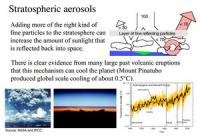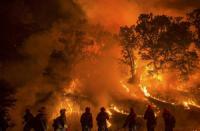-
Geoengineer the planet? More scientists now say it must be an option

Once seen as spooky sci-fi, geoengineering to halt runaway climate change is now being looked at with growing urgency. A spate of dire scientific warnings that the world community can no longer delay major cuts in carbon emissions, coupled with a recent surge in atmospheric concentrations of CO2, has left a growing number of scientists saying that it’s time to give the controversial technologies a serious look. Fred Pearce writes in Yale Environment 360 that among the technologies being considered are a range of efforts to restrict solar radiation from reaching the lower atmosphere, including spraying aerosols of sulphate particles into the stratosphere, and refreezing rapidly warming parts of the polar regions by deploying tall ships to pump salt particles from the ocean into polar clouds to make them brighter.
-
-
How climate change impacts the economy
Warmer temperatures, sea level rise and extreme weather will be deleterious to the U.S. economy: Rising temperatures damage property and critical infrastructure, impact human health and productivity, and negatively affect sectors such as agriculture, forestry, fisheries, and tourism. The demand for energy will increase as power generation becomes less reliable, and water supplies will be stressed. Damage to other countries around the globe will also affect U.S. business through disruption in trade and supply chains.
-
-
Optimizing use of future wave electricity generators during disaster
When hurricanes strike, loss of electricity ranks as one of the top concerns for relief workers. Blackouts lasting a week or more can hamper recovery efforts, shutter hospitals, threaten public health and disrupt transportation. The months-long effort to restore power to Puerto Rico following the 2017 hurricane season has led to renewed interest in finding innovative ways to get affected power grids back online. Researchers look to develop a strategy for how floating devices that harness the energy of the oceans’ waves might be able to provide this much needed aid.
-
-
Satellite observations help in earthquake monitoring, response
Researchers have found that data gathered from orbiting satellites can provide more accurate information on the impact of large earthquakes, which, in turn, can help provide more effective emergency response.
-
-
As global temperatures climb, risk of armed conflict likely to increase substantially
As global temperatures climb, the risk of armed conflict is expected to increase substantially, according to experts across several fields. Synthesizing views across experts, the study estimates climate has influenced between 3 percent and 20 percent of armed conflict risk over the last century and that the influence will likely increase dramatically.
-
-
Drones help in early detection of forest fires
Researchers have developed a drone-based system for early detection and prevention of forest fires through drone technology. Sensors can detect fire from 15 kilometers away, and autonomously send drones to investigate, even in conditions of limited visibility, and gathers optic and thermal images of the fire, which the drone sends back in real time.
-
-
A “Responsibility to Prepare”: A strategy for presidential leadership on the security risks of climate change
Presidential candidates are offering their plans on climate change, and it’s a competition over who’s the most ambitious. That’s good news, given that it’s a major security threat that requires a major response. Thus far, most of the candidates’ plans understandably focus on reducing greenhouse gas emissions and transitioning to a low-carbon economy. These steps are critically important, not least because the world will likely experience significant security disruptions in the future if the scale and scope of climate change are not reduced. Caitlin Werrell, Francesco Femia, and John Conger write in War in the Rocks that this is only half a strategy. Indeed, if there is a silver lining to climate change and the attendant security risks, it’s that we can see many of these changes coming. American scientists, the U.S. government (see this administration’s National Climate Assessment) and private industry have all shown they are capable of modeling climate change futures with a high degree of certainty compared to other trends. A climate model from 1967 still has a strong predictive capacity. Exxon’s own internal calculations and climate modeling from 1982 about where emissions would likely be in the future, including by 2020, were fairly spot-on. A political scientist in 1967 or 1982 would have had much more difficulty predicting what the political landscape would look like in 2020 than she or he would have making predictions about the climate.
-
-
More frequent downpours of torrential rain with global warming
The frequency of downpours of heavy rain—which can lead to flash floods, devastation, and outbreaks of waterborne disease—has increased across the globe in the past 50 years, a period when global warming also intensified
-
-
Climate change is destroying a barrier that protects the U.S. East Coast from hurricanes
Severe hurricanes can cost up to hundreds of billions of dollars in damages. The destruction left in the wake of Atlantic hurricanes has been increasing over time in recent decades. A new study suggests that climate change could soon eliminate an atmospheric barrier that protects much of the U.S. East Coast from powerful hurricanes.
-
-
Dream of ideal “invisibility” cloaks for stress waves dashed
Whether Harry Potter’s invisibility cloak, which perfectly steers light waves around objects to make them invisible, will ever become reality remains to be seen, but perfecting a more crucial cloak is impossible, a new study says. It would have perfectly steered stress waves in the ground, like those emanating from a blast, around objects like buildings to make them “untouchable.”
-
-
Small towns, big flood waters
Climate change is bringing more water to people’s doorsteps, devastating communities. For some floodplain towns, survival comes down to sink, swim, or rise. Entire towns are moving to escape rising waters. But how do towns address these growing threats and still retain their sense of community? But how do you move an entire town? lood experts at UC Davis are visiting dozens of communities to find out. This is the story of two of those towns.
-
-
The economic cost of devastating hurricanes and other extreme weather events is even worse than we thought
June marks the official start of hurricane season. If recent history is any guide, it will prove to be another destructive year thanks to the worsening impact of climate change. If this is not bad enough, there is this: a meaningful assessment of the costs of climate change – using basic economic principles I teach to undergrads – paints a scary picture indeed.
-
-
Scam contractors preying on victims of natural disasters
Following a natural disaster or strong storm like Hurricane Florence, there is usually a second wave of potential destruction – scam artists looking to line their pockets. “After any major weather-related incident, insurance adjusters and contractors swarm the affected area and, unfortunately, some are looking to take advantage of those in distress,” says one expert.
-
-
Telling early moment that indicates a coming megaquake
Just 10 seconds into a quake, GPS data can detect signs of acceleration that point to an event’s magnitude. Likewise, that moment — gleaned from GPS data on the peak rate of acceleration of ground displacement — can indicate a smaller event.
-
-
More intense wildfires are here to stay, and we need to adapt

Update on state of Canada’s mountain regions looks at human scale of ecological disaster wrought by changing climate. “Events that a decade ago we would call ‘100-year events’ are quickly becoming the norm,” said one researcher. We need to talk “about ways we can coexist with fire because it is our new reality.”
-
- All
- Regional
- Water
- Biometrics
- Borders/Immig
- Business
- Cybersecurity
- Detection
- Disasters
- Government
- Infrastructure
- International
- Public health
- Public Safety
- Communication interoperabillity
- Emergency services
- Emergency medical services
- Fire
- First response
- IEDs
- Law Enforcement
- Law Enforcement Technology
- Military technology
- Nonlethal weapons
- Nuclear weapons
- Personal protection equipment
- Police
- Notification /alert systems
- Situational awareness
- Weapons systems
- Sci-Tech
- Sector Reports
- Surveillance
- Transportation
Advertising & Marketing: advertise@newswirepubs.com
Editorial: editor@newswirepubs.com
General: info@newswirepubs.com
2010-2011 © News Wire Publications, LLC News Wire Publications, LLC
220 Old Country Road | Suite 200 | Mineola | New York | 11501
Permissions and Policies
Editorial: editor@newswirepubs.com
General: info@newswirepubs.com
2010-2011 © News Wire Publications, LLC News Wire Publications, LLC
220 Old Country Road | Suite 200 | Mineola | New York | 11501
Permissions and Policies
